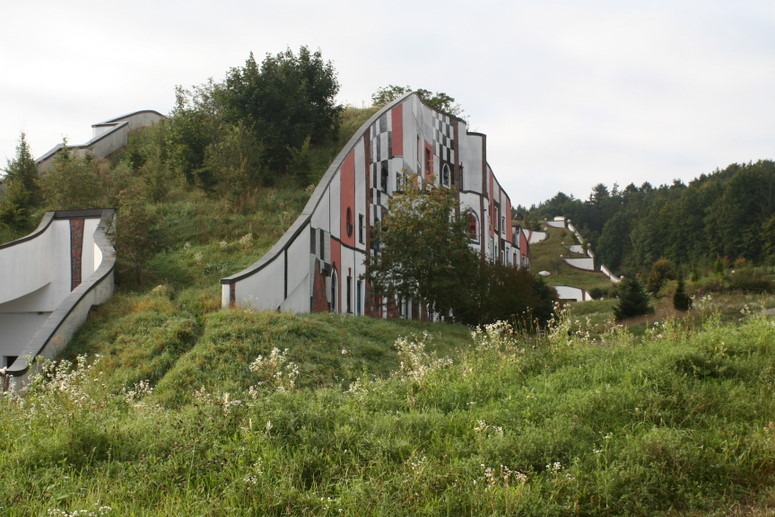
Hundertwasser's design for Spa Blumeau increases the urban area while allowing a vegetated landscape to develop
The most popular urban design policy is NIMBY Not In My Back Yard: lets keep on building but lets do it somewhere else. This may change when we all come to see the Earth as our Back Yard. Meanwhile, how can we make urbanization more popular? There are about three times as many humans on earth today as on the day I was born. If this trend continues, as is projected, we need a lot of space for urban sprawl or we need to intensify the use of each square meter which is already urbanized. How can either policy be popular? My suggestion is asking landscape architects to study plots of land and find ways of simultaneously (1) creating more indoor space (2) creating more greenspace which is both useful and accessible to the public. This can be done in lots of ways and one of the best examples comes from the work of the Austrian artist-designer Friedensreich Hundertwasser. At Spa Blumeau, illustrated above, he took some tired farmland and made a popular spa with, I guess, more wildlife and vegetation than before the development took place.
See the Landscape Urbanism Blog and Wiki on Landscape Urbanism Landscape Urbanism is a theory of urbanism which argues that landscape, rather than architecture, is more capable of organizing the city and enhancing the urban experience.

The use of mapping to identify hidden statistical relationships for example between parks and childhood obesity is a useful tool for starting to understand complex social problems. [ http://landscapeandurbanism.blogspot.com/2009/06/cause-effect.html ]I often hear said that parents keep their children within the home because they consider the streets and neighbourhoods to be unsafe?
Yes, I believe GIS analysis should become as essential to park design as it is to retail planning and all other types of spatial allocation. It could also inform parents which parks are safe and which are dangerous.
So the question becomes what is the ‘essence’ of safety?
Just spotted there is a programme on tonight on Radio 3 at 9.30pm about Ebenezer Howard’s ‘Garden City’. I am sure it will remain on iplayer/listen again for a week at least. See link:
http://www.bbc.co.uk/programmes/b00n6tl3
‘The garden city was the utopian brain-child of a humble British clerk, Ebenezer Howard, who imagined a new kind of settlement that would fuse the best of town and country, creating not just decent living places for ordinary people, but a new social harmony.’
Thank you for the note. Howard is a good example of the principle that professionals are not always the best at doing the profession they profess to. Howard’s idea of a Garden City was better than the Garden Cities built in the 1920s and 1930s, which were better than the New Towns built after 1947.
Predicting the future always seems to be a fraught task!
There have been popular predictions of global freezing [ http://en.wikipedia.org/wiki/Global_cooling ]which were almost as well accepted as current predictions of global warming [ http://en.wikipedia.org/wiki/Global_warming. ]
Perhaps the big freeze was averted as aerosols were thought to be the dominant cause of mid-twentieth century cooling? So I suppose the logic is if we address the carbon cycle perhaps we will avert global warming?
Under [ http://en.wikipedia.org/wiki/Population_decline ] and over [ http://en.wikipedia.org/wiki/Overpopulation ]population predictions seem also to alternate.
The key factor in debates on underpopulation seem to be economics while the key factor in the debates on overpopulation seem to be environmental.